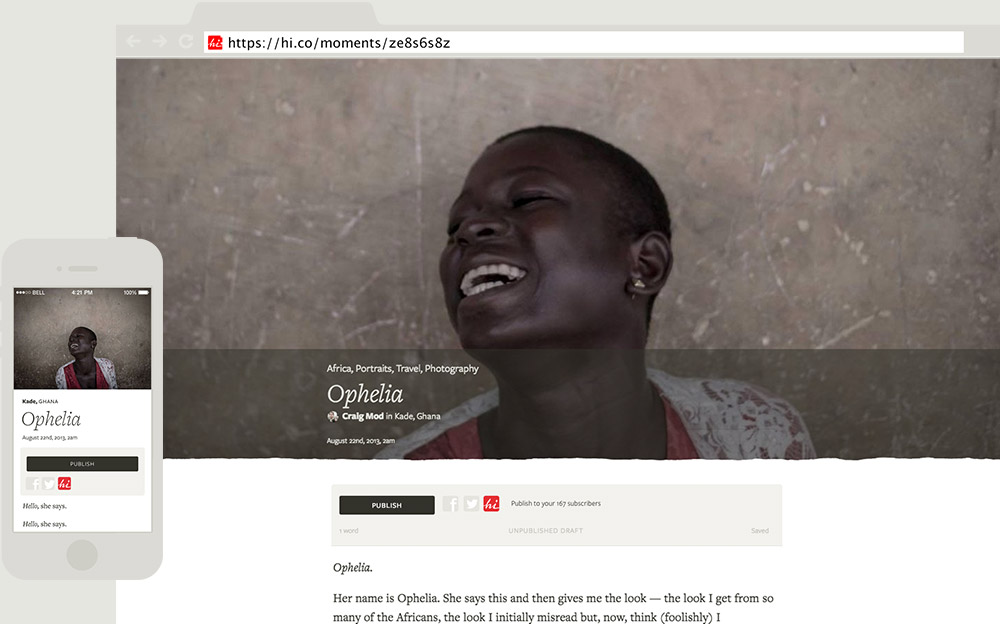The digital revolution has upended the media and publishing industries in recent years with its ability to give more content producers more platforms on which to be heard, and audiences a near constant stream of (mostly free) news and opinions to consume.
Yet despite this shift, the process of writing and reading has remained largely unchanged. Sure, authors and journalists have adopted a new set of online creation tools, but once a story has been published, it quickly becomes just another static piece of content that gets buried beneath an avalanche of what’s new and next. Although readers can share their favorite articles on social channels alongside their own point of view, they’re largely consuming these bits of content inside a vacuum devoid of context or meaningful dialogue.
Though the shelf life of a well-researched academic paper may be slightly longer than something that’s a part of the standard news cycle, it’s important that publishers embrace new social tools and platforms to rescue their authors’ works from simply becoming another historical footnote by helping their content become more dynamic and expansive.

One of social’s biggest impacts has been its rewriting of the rules defining expertise. Prior to the introduction of social channels, when a reader agreed or disagreed with an author’s assertions they had few options for discussion. Now they can instantly connect with an audience of peers (and sometimes the writer themselves) to speak about the merits or shortcomings of a particular piece of work. The democratization afforded by these tools has taken publishing from a top-down model into a two-way conversation, giving rise to powerful new voices, which otherwise wouldn’t be heard. Not only does this ongoing commentary add value to an article once it’s been published, but it also calls into question the very notion of a finished piece of work. To put it more simply, when readers start making meaningful contributions to the telling of a story, should it continually be updated to reflect those relevant facts or is their mere mention enough?
Consider the way some breaking news reporting has adapted alongside the realities of Twitter. As live events are pushed out to the public, many media outlets are moving to incorporate images, video and reactions being shared by individuals in the affected locale. This more collaborative form of storytelling recognizes the value of sharing multiple points of view, which can sometimes even call previous suppositions into doubt. While this model is only viable for certain kinds of articles, it’s important to consider how similar innovations can be applied to the current process of academic publishing.
One platform looking to make the process of research and writing more iterative is Hi. The community-powered site offers a “full stack” of creation tools that are intended to bring writers and their audiences closer together throughout the process, whether that is by helping with the development of a story idea or providing feedback after an initial draft.

Hi’s founder Craig Mod explains the benefits of this model in a company blog post:
“The biggest advantage is that it’s easy to weave community into each stage of the writing process. This creates a unique intimacy with an audience. It also makes building an audience feel accessible. In fact, writing on Hi feels less like using a set of tools and more like having an increasingly deepening, extended conversation.”
While not all authors may be ready to turn their writing process over to the wisdom of the crowd, most should welcome the value of healthy debate once their work goes live. Active discussion not only amplifies the reach of a published article, but also has the potential to surface relevant insights that can further the goals of research and/or place that research within the broader context of a field of study. In the same way that readers have been able to scribble notes in the margins since the dawn of printed text, new commenting tools are bringing the power of annotations to the digital world.
One such service is Lifefyre’s Sidenotes application, which allows readers to directly engage with specific elements of an article whether that is a quote, paragraph or image by leaving comments and sparking conversation streams.
Popular sites like Quartz and Medium have already adopted similar tools. In describing the thinking behind the decision to add this feature, Quartz senior editor Zach Seward explains, “We have a really smart audience, a lot of our readers have a lot to add, and we certainly believe in that mantra that collectively they know more than we do. So we wanted to try to design a system that would take advantage of that and give space for their thoughtful contributions while avoiding the traditional pitfalls of comments.”

While the fantasy of a genius toiling away in solitude before making a monumental discovery is still possible, it’s more likely that they will have had some help along the way. That assistance may come from of a singular reader comment that refined a key insight, or a sustained conversation that enabled the work to reach a much larger audience. These external catalysts are especially important in today’s saturated publishing landscape where the margin between good and great thinking is razor thin, and only the most innovative ideas gain traction. Given these realities, it’s vital that publishers provide their authors and audiences access to an emerging set of social tools, ensuring that the best research and hypotheses can be magnified through the free exchange of assenting and dissenting points of view and related context. These articles then, can become focal points of a much larger conversation, helping advance the goals of the authors and their audiences.
This article was originally published on Wiley Exchanges.

Thanks for flagging this SlideShare!
Oops! An error has occurred.
1 of 58
Like this ? Why not share!
- PSFK Gift Guide 2014 by PSFK 4329 views
- PSFK Future of Retail 2015 Report -... by PSFK 130637 views
- The future of retail 2015 by Ikusmer Observato... 1832 views
- PSFK - The future of wearable tech by Digital Insurance 1261 views
- Future of wearable technology by Hal Woode 1559 views
- El futuro del trabajo by Oscar Casimiro 53 views
- The future of work by thaiscarbonell1512 673 views
- PSFK's Future of Retail Report 2010 by PSFK 214239 views
- PSFK presents Future Of Health by PSFK 117394 views
- Futureofhealth slideshareversion-10... by Jessica Feinberg-... 3432 views
- The Future of Retail by Ivonne Kinser 1813 views
- PSFK presents Future Of Mobile Tagg... by PSFK 160976 views

Future of Research from PSFK
It’s been possible to scan and print 3D models of somebody’s head and shoulders for a few years now, and folks in areas as diverse as medicine, the arts and fashion have put that capability to good use, but we’ve yet have had something that let us print full-body models. Last month, itSeez3D released an update to its popular 3D scanner app that broadens the scope to include full-body models.
It uses an iPad and Structure Sensor to gather 3D data via a series of photos taken from different angles around (and above) the person. As photos are taken, it provides feedback to indicate which parts of the body still need coverage. Once complete, the app sends the images to the cloud where the images are combined to create the model.

- Medical — the benefits of a cheap, easy to use means of modeling a patient or part of a patient could be significant and broad-sweeping
- Retail — in clothing, sports outfitting and even travel, the idea of a three-dimensional catalog of figurines wearing or using products could enhance the concept of a catalog
- Fashion — much like retail, the power of printing prototype figurines of models dressed in different clothes can help drive decisions about what lines move forward
- Gaming — prototype or personalized game pieces for everything from Monopoly to role-playing games
Sasha
More Less
Like Unlike
Thanks!
Also share?
itSeez3D Pro View on Sketchfab
- Help
- Viewer mode
- Orbit
- First person

The update also offers the ability to scan with up to 150 percent the resolution texture of the earlier version. It’s free iPad for private consumers. Businesses can use it for free, and are charged per printed model.

